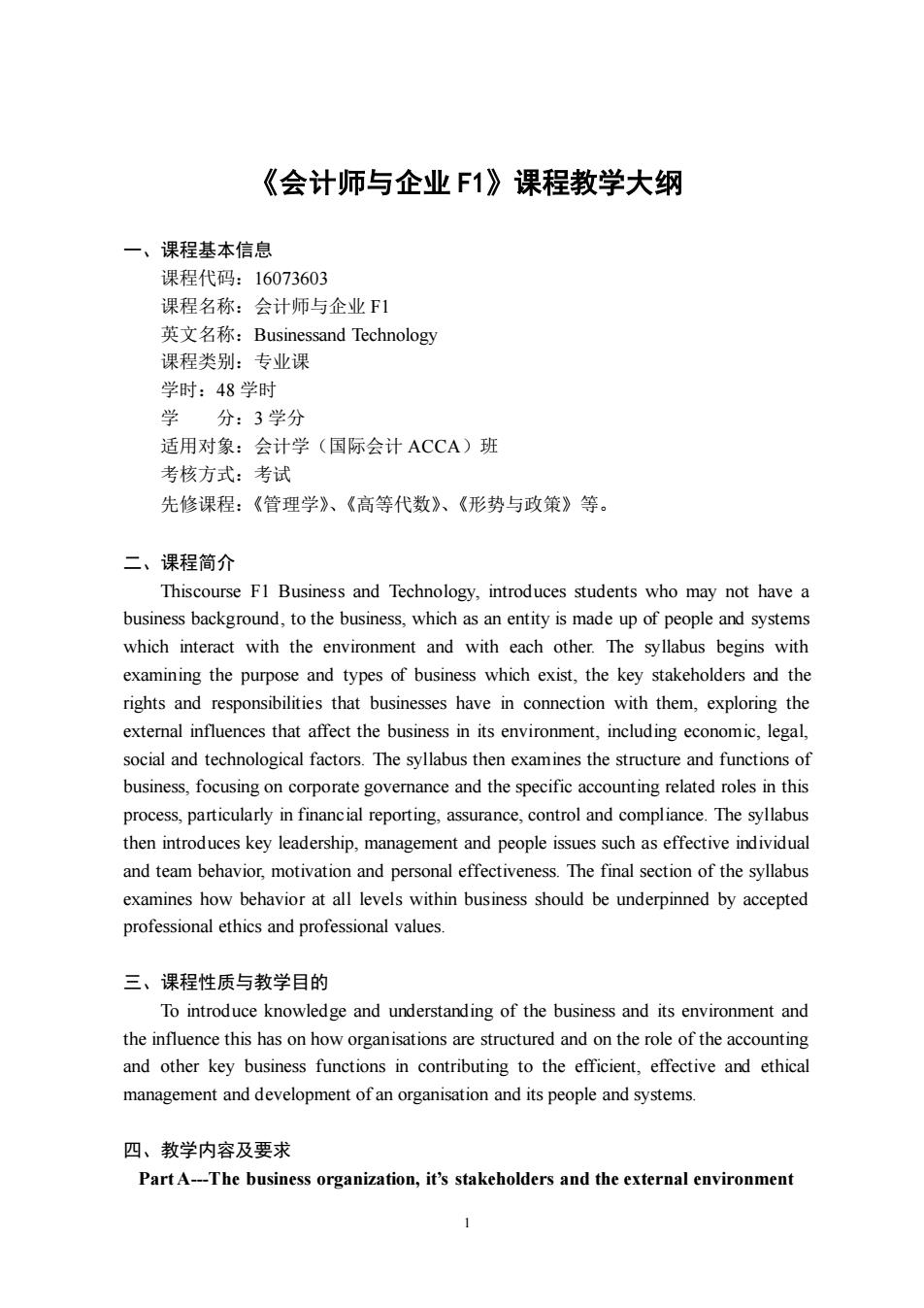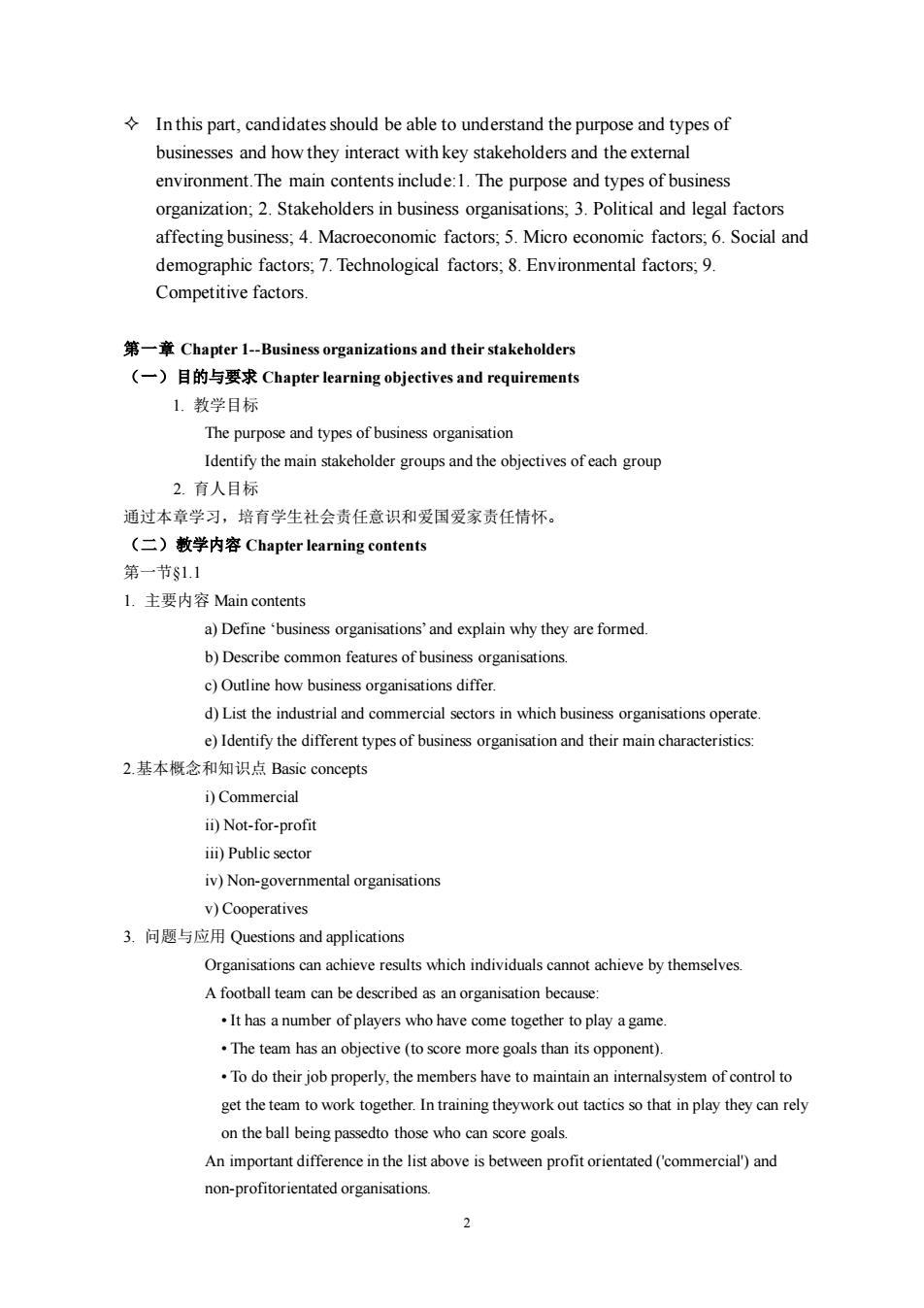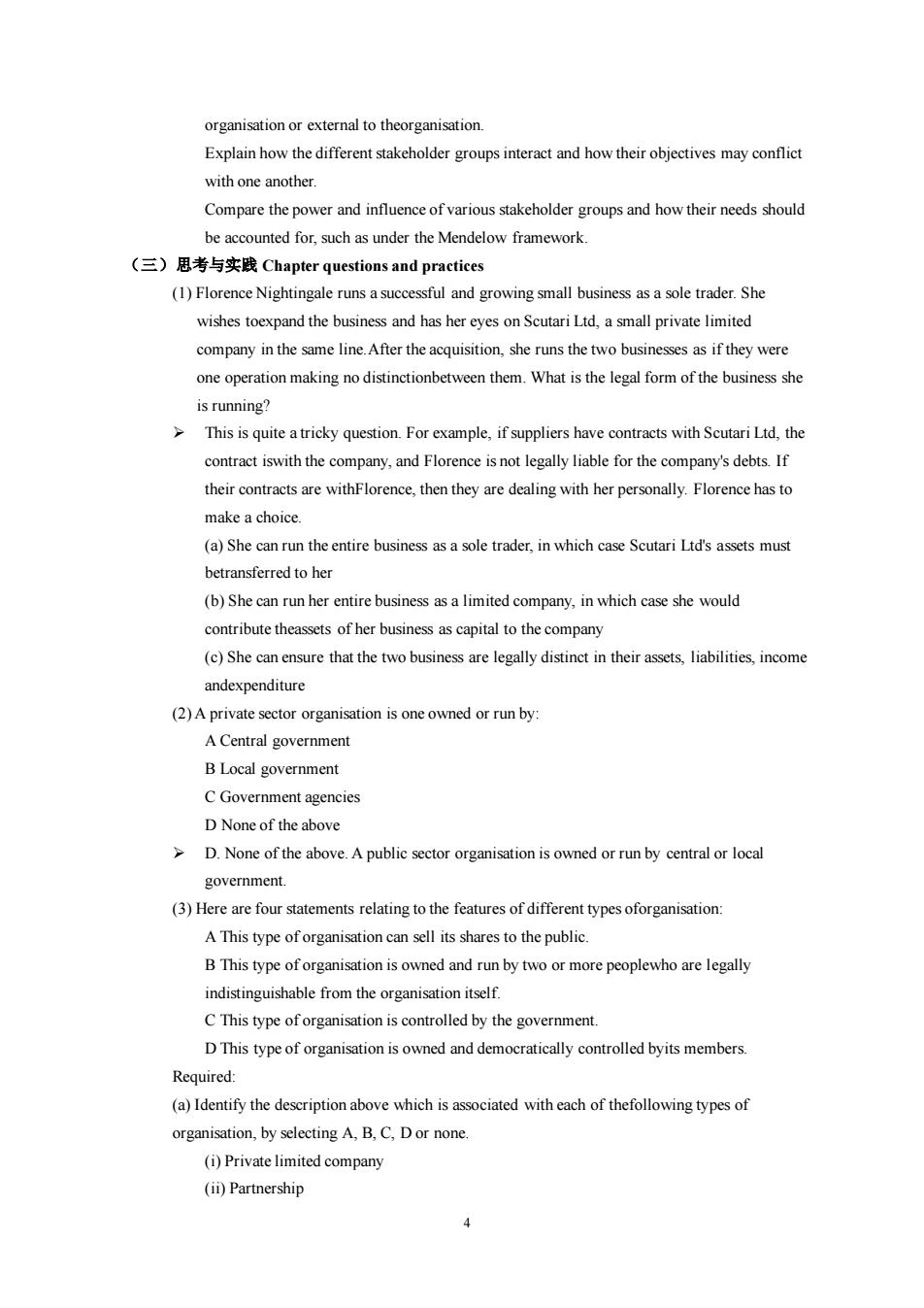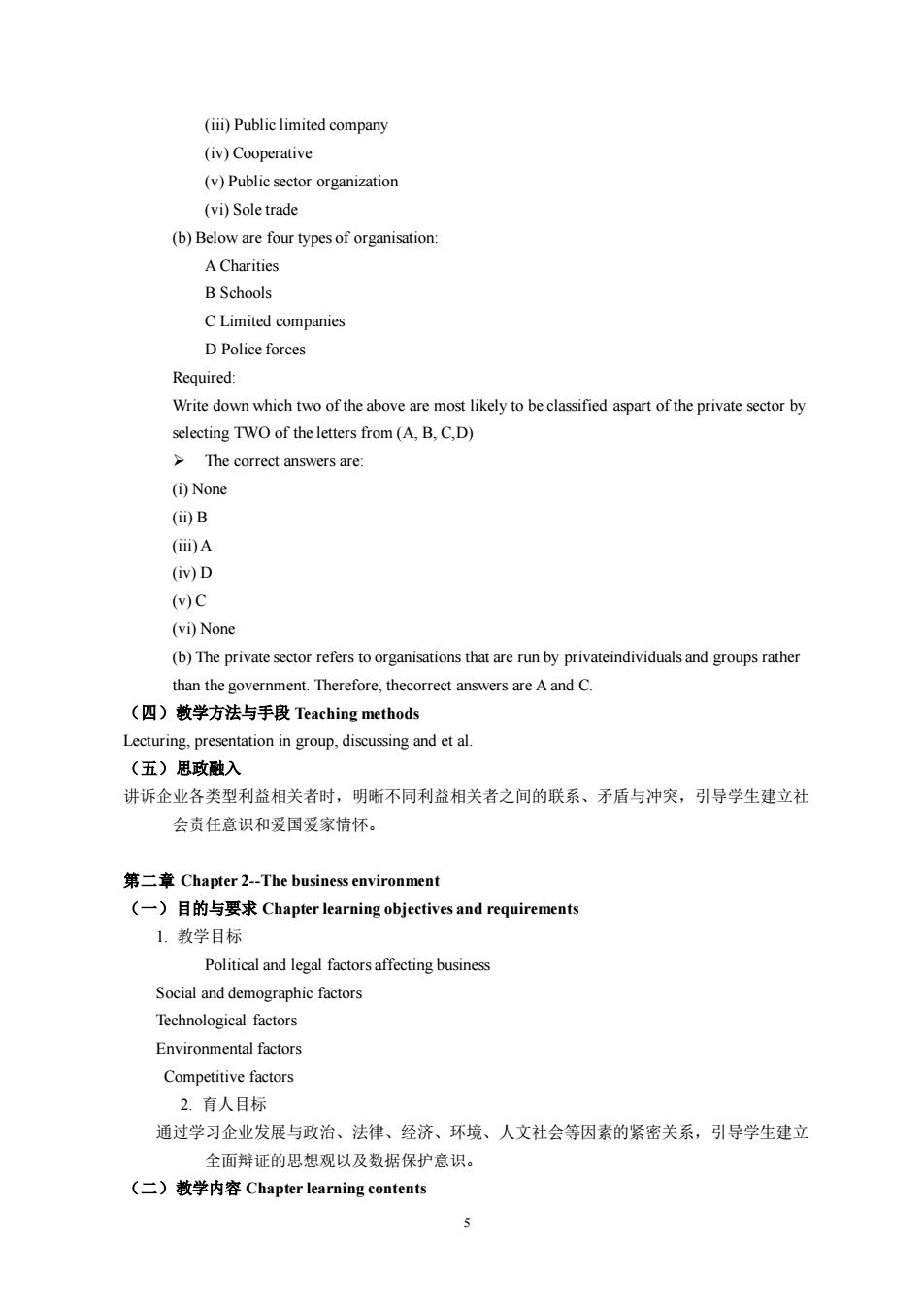
《会计师与企业F1》课程教学大纲 一、课程基本信息 课程代码:16073603 课程名称:会计师与企业F1 英文名称:Businessand Technology 课程类别:专业课 学时:48学时 学 分:3学分 适用对象:会计学(国际会计ACCA)班 考核方式:考试 先修课程:《管理学》、《高等代数》、《形势与政策》等。 二、课程简介 Thiscourse FI Business and Technology,introduces students who may not have a business background,to the business,which as an entity is made up of people and systems which interact with the environment and with each other.The syllabus begins with examining the purpose and types of business which exist,the key stakeholders and the rights and responsibilities that businesses have in connection with them,exploring the external influences that affect the business in its environment,including economic,legal, social and technological factors.The syllabus then examines the structure and functions of business,focusing on corporate governance and the specific accounting related roles in this process,particularly in financial reporting.assurance.control and compliance.The syllabus then introduces key leadership,management and people issues such as effective individual and team behavior,motivation and personal effectiveness.The final section of the syllabus examines how behavior at all levels within business should be underpinned by accepted professional ethics and professional values. 三、课程性质与教学目的 To introduce knowledge and understanding of the business and its environment and the influence this has on how organisations are structured and on the role of the accounting and other key business functions in contributing to the efficient,effective and ethical management and development of an organisation and its people and systems 四、教学内容及要求 Part A-The business organization,it's stakeholders and the external environment 1
1 《会计师与企业 F1》课程教学大纲 一、课程基本信息 课程代码:16073603 课程名称:会计师与企业 F1 英文名称:Businessand Technology 课程类别:专业课 学时:48 学时 学 分:3 学分 适用对象:会计学(国际会计 ACCA)班 考核方式:考试 先修课程:《管理学》、《高等代数》、《形势与政策》等。 二、课程简介 Thiscourse F1 Business and Technology, introduces students who may not have a business background, to the business, which as an entity is made up of people and systems which interact with the environment and with each other. The syllabus begins with examining the purpose and types of business which exist, the key stakeholders and the rights and responsibilities that businesses have in connection with them, exploring the external influences that affect the business in its environment, including economic, legal, social and technological factors. The syllabus then examines the structure and functions of business, focusing on corporate governance and the specific accounting related roles in this process, particularly in financial reporting, assurance, control and compliance. The syllabus then introduces key leadership, management and people issues such as effective individual and team behavior, motivation and personal effectiveness. The final section of the syllabus examines how behavior at all levels within business should be underpinned by accepted professional ethics and professional values. 三、课程性质与教学目的 To introduce knowledge and understanding of the business and its environment and the influence this has on how organisations are structured and on the role of the accounting and other key business functions in contributing to the efficient, effective and ethical management and development of an organisation and its people and systems. 四、教学内容及要求 Part A---The business organization, it’s stakeholders and the external environment

In this part,candidates should be able to understand the purpose and types of businesses and how they interact withkey stakeholders and the extemal environment The main contents include:1.The purpose and types of business organization;2.Stakeholders in business organisations,3.Political and legal factors affecting business,4.Macroeconomic factors,5.Micro economic factors,6.Social and demographic factors;7.Technological factors,8.Environmental factors,9. Competitive factors 第一章Chapter 1-Business organizations and their stakeholder (一)目的与要求Chapter learning objectives and requirements 1.教学目标 The purpose and types of business organisation Identify the main stakehoder groupsand the objectives 2.有人目标 通过本章学习,培有学生社会责任意识和爱国爱家责任情怀 (二)教学内容Chapter learning contents 第一节1.1 L.主要内容Main contents a)Definebusiness organisations'and explain why they are formed b)Describe common features of business organisations. )Outline how business organisations differ d)List the industrial and commercial sectors in which business organisations operate e)Identify the different typesof business organisation and their maincharacteristics 2.基本概念和知识点Basic concepts i)Commercial ii)Not-for-profit iii)Public sector iv)Non-governmental organisations v)Cooperatives 3.问题与应用Questions and applications Organisations can achieve results which individuals cannot achieve by themselves. A football team can be described as an organisation becaus It has a number of players who have come together to play a game .The team has an objective(to score more goals than its opponent) .To do their job properly,the members have to maintain an internalsystem of control to get the te to work together.theyworkou tactics so that in play they can rely on the ball being passedto those who can score goals An important difference in the list above is between profit orientated(commercialand non-profitorientated organisations. 2
2 In this part, candidates should be able to understand the purpose and types of businesses and how they interact with key stakeholders and the external environment.The main contents include:1. The purpose and types of business organization; 2. Stakeholders in business organisations; 3. Political and legal factors affecting business; 4. Macroeconomic factors; 5. Micro economic factors; 6. Social and demographic factors; 7. Technological factors; 8. Environmental factors; 9. Competitive factors. 第一章 Chapter 1--Business organizations and their stakeholders (一)目的与要求 Chapter learning objectives and requirements 1. 教学目标 The purpose and types of business organisation Identify the main stakeholder groups and the objectives of each group 2. 育人目标 通过本章学习,培育学生社会责任意识和爱国爱家责任情怀。 (二)教学内容 Chapter learning contents 第一节§1.1 1. 主要内容 Main contents a) Define ‘business organisations’ and explain why they are formed. b) Describe common features of business organisations. c) Outline how business organisations differ. d) List the industrial and commercial sectors in which business organisations operate. e) Identify the different types of business organisation and their main characteristics: 2.基本概念和知识点 Basic concepts i) Commercial ii) Not-for-profit iii) Public sector iv) Non-governmental organisations v) Cooperatives 3. 问题与应用 Questions and applications Organisations can achieve results which individuals cannot achieve by themselves. A football team can be described as an organisation because: • It has a number of players who have come together to play a game. • The team has an objective (to score more goals than its opponent). • To do their job properly, the members have to maintain an internalsystem of control to get the team to work together. In training theywork out tactics so that in play they can rely on the ball being passedto those who can score goals. An important difference in the list above is between profit orientated ('commercial') and non-profitorientated organisations

The that make up the vary country,but generally include: ·police military public transport ·primary education healthcare for the poor The private secor will therefore normaly include Within these will be both profitseeking and notforprofitorganisations businesses charities and ·clubs. A non-governmental organisation(NGO)is a legally constituted organisation of people acting togetherindependently from any form of government. NGOs include .the Red Cross .Doctors Without Borders ·Greenpeace .Amnesty International In the UK,the largest example of a co-operative is the Co-operative Group,which has over 5.5million members and operates in diverse markets.such as banking.travel and groceries 第二节§1.2 L.主要内容Main contents a)Define stakeholders and explain the agency relationship in business and how it may vary in different types of business organisaion. b)Define internal,connected and external stakeholders and explain their impact on the organisation. c)Identify the main stakeholder groups and the objectives of each group. )Explain how the different how their objectives may conflict with one another. e)Compare the power and ofvarious stakeholder groupsand how theirneeds should be accounted for,such as under the Mendelow framework. 2.基本概念和知识点Basic concepts internal,connected and external stakeholders Stakeholders are those individuals or groups that,potentially,have an interest in what the organizationdoes These stakeholders can be within to the 3
3 The organisations that make up the public sector vary from country to country, but generally include: • police • military • public transport • primary education • healthcare for the poor The private sector will therefore normally include: Within these will be both profitseeking and notforprofitorganisations. • businesses • charities and • clubs. A non-governmental organisation (NGO) is a legally constituted organisation of people acting togetherindependently from any form of government. NGOs include: • the Red Cross • Doctors Without Borders • Greenpeace • Amnesty International In the UK, the largest example of a co-operative is the Co-operative. Group, which has over 5.5 million members and operates in diverse markets, such as banking, travel and groceries 第二节§1.2 1. 主要内容 Main contents a) Define stakeholders and explain the agency relationship in business and how it may vary in different types of business organisation. b) Define internal, connected and external stakeholders and explain their impact on the organisation. c) Identify the main stakeholder groups and the objectives of each group. d) Explain how the different stakeholder groups interact and how their objectives may conflict with one another. e) Compare the power and influence of various stakeholder groups and how their needs should be accounted for, such as under the Mendelow framework. 2. 基本概念和知识点 Basic concepts internal, connected and external stakeholders 3. 问题与应用 Questions and applications Stakeholders are those individuals or groups that, potentially, have an interest in what the organizationdoes. These stakeholders can be within the organisation, connected to the

organisation or external to theorganisation. Explain how the different stakeholder groups interact and how theirobjectives may confic with one another Compare the power and influence of various stakeholder groups and how their needs should be accounted for,such as under the Mendelow framework. (三)思考与实践Chapter questions and practices (1)Florence Nightingale runs asuccessful and growing small business asasole trader.She wishes toexpand the business and has her eyes on Scutari Ltd,a small private limited company in the same lineAfter the acquisition,she runs the two businesses as if they were one operation making no distinctionbetween them.What is the legal form of the business she isrunning? >This is quite a tricky question.For example.if suppliers have contracts with Scutari Ltd.the contract iswith the company,and Forence isnot legally liable for the company's debts.If their contracts are withFlorence,then they are dealing with her personally.Florence has to make a choice. (a)She can run theentire business as a sole trader,in which case Scutari Ld's assets must betransferred to her (b)She can run her entire business as a limited company,in which case she would contribute theassets of her business as capital to the company (e)She can ensure that the two business are legally distinct in their assets,liabilities,income andexpenditure (2)A private sector organisation is one owned or run by: A Central government B Local government C Government agencies D None of the above >D.None of the above.A public sector organisation is owned or run by central or local government. (3)Here are four statements relating to the features of different types oforganisation: AThis type of organisation can sell its shares to the public. B This type of organisation is owned and run by two or more peoplewho are legally indistinguishable from tsef C This type of organisation is controlled by the government. DThis type of organisation is owned and democratically conrolled byits members Required: (a)Identify the description bove which is with each of thefollowing types of organisation,by selecting A.B.C.Dor none. (i)Private limited company (ii)Partnership
4 organisation or external to theorganisation. Explain how the different stakeholder groups interact and how their objectives may conflict with one another. Compare the power and influence of various stakeholder groups and how their needs should be accounted for, such as under the Mendelow framework. (三)思考与实践 Chapter questions and practices (1) Florence Nightingale runs a successful and growing small business as a sole trader. She wishes toexpand the business and has her eyes on Scutari Ltd, a small private limited company in the same line.After the acquisition, she runs the two businesses as if they were one operation making no distinctionbetween them. What is the legal form of the business she is running? ➢ This is quite a tricky question. For example, if suppliers have contracts with Scutari Ltd, the contract iswith the company, and Florence is not legally liable for the company's debts. If their contracts are withFlorence, then they are dealing with her personally. Florence has to make a choice. (a) She can run the entire business as a sole trader, in which case Scutari Ltd's assets must betransferred to her (b) She can run her entire business as a limited company, in which case she would contribute theassets of her business as capital to the company (c) She can ensure that the two business are legally distinct in their assets, liabilities, income andexpenditure (2) A private sector organisation is one owned or run by: A Central government B Local government C Government agencies D None of the above ➢ D. None of the above. A public sector organisation is owned or run by central or local government. (3) Here are four statements relating to the features of different types oforganisation: A This type of organisation can sell its shares to the public. B This type of organisation is owned and run by two or more peoplewho are legally indistinguishable from the organisation itself. C This type of organisation is controlled by the government. D This type of organisation is owned and democratically controlled byits members. Required: (a) Identify the description above which is associated with each of thefollowing types of organisation, by selecting A, B, C, D or none. (i) Private limited company (ii) Partnership

(i)Public limited company (iv)Cooperative (v)Public sector organization (vi)Sole trade (b)Below are four typesof organisation A Charities CLimited companies D Police forces Required: Write down which two of the above are most likely to be classified aspart of the private sector by selecting TWO of the letters from(A.B.C.D) The correct answers are: (i)None (ii)B (iiD)A (iv)D (v)C (vi)None (b)The private sector refers to organisations that are run by privateindividuals and groups rather than the government.Therefore,thecorrect answers are Aand C. (四)教学方法与手段Teaching methods Lecturing.presentation in group,discussing and et al (五)思政融入 讲诉企业各类型利益相关者时,明晰不同利益相关者之间的联系、矛后与冲突,引导学生建立社 会责任意识和爱国爱家情怀。 第二章Chapter2-The business environment (一)目的与要求Chapter learning objectives and requirements 1.教学目标 Political and legal factors affecting business Social and demographic factors Technological factors Environmental factors Competitive factors 2.育人目标 通过学习企业发展与政治、法律、经济、环境、人文社会等因素的紧密关系,引导学生建立 全面辩证的思想观以及数据保护意识。 (二)教学内容Chapter learning contents 5
5 (iii) Public limited company (iv) Cooperative (v) Public sector organization (vi) Sole trade (b) Below are four types of organisation: A Charities B Schools C Limited companies D Police forces Required: Write down which two of the above are most likely to be classified aspart of the private sector by selecting TWO of the letters from (A, B, C,D) ➢ The correct answers are: (i) None (ii) B (iii) A (iv) D (v) C (vi) None (b) The private sector refers to organisations that are run by privateindividuals and groups rather than the government. Therefore, thecorrect answers are A and C. (四)教学方法与手段 Teaching methods Lecturing, presentation in group, discussing and et al. (五)思政融入 讲诉企业各类型利益相关者时,明晰不同利益相关者之间的联系、矛盾与冲突,引导学生建立社 会责任意识和爱国爱家情怀。 第二章 Chapter 2--The business environment (一)目的与要求 Chapter learning objectives and requirements 1. 教学目标 Political and legal factors affecting business Social and demographic factors Technological factors Environmental factors Competitive factors 2. 育人目标 通过学习企业发展与政治、法律、经济、环境、人文社会等因素的紧密关系,引导学生建立 全面辩证的思想观以及数据保护意识。 (二)教学内容 Chapter learning contents